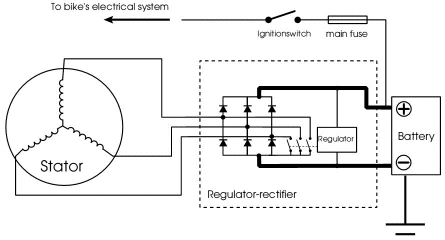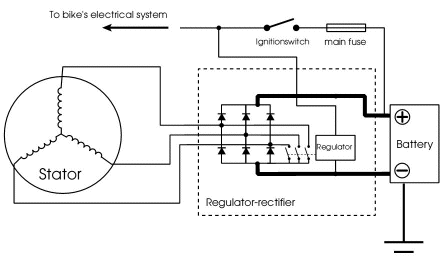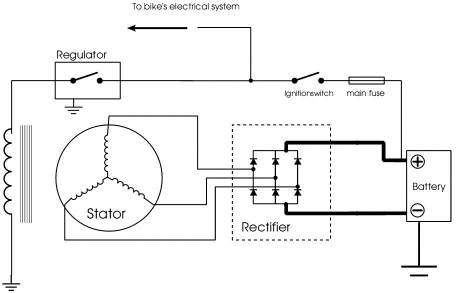|
|
||||||||||||||||||||||||||||||
|
||||||||||||||||||||||||||||||
 |
 |
|||||||||||||||||||||||||||||
|
Technical Article: How a Motorcycle Charging System WorksThe Basics of a Motorcycle Charging SystemOn almost every motorcycle you will find a battery, used for providing power for starting the bike and for buffering an amount of electric energy. The battery itself is charged by a generator driven by the engine, and as long as the engine is running there will be a current flowing through thebattery. The no load voltage of a fully charged battery is about 13 Vdc. For charging it the charging-system should provide a voltage of about 14.4 Vdc and this should be a constant voltage at all engine-speeds. The generator itself is located in or on the engine, and on most bikes there is a separate regulator-rectifier unit located somewhere on the frame. The reason for this is that almost all motorcycles are equipped with a three-phase AC (Alternating Current) generator, while the electrical system on the bike is a DC (Direct Current) system. The rectifier part inside the regulator-rectifier takes care of converting the AC-current to the DC-current the battery needs. The three-phase AC generator is used so often because it is much more efficient and reliable than a DC-generator. It can produce power for charging the battery even with the engine idling. The regulator part of the regulator-rectifier is used to regulate the output-voltage (to the battery) to the 14.4 Vdc that is needed. The Permanent Magnet Generator System A generator on a bike is producing this electrical power because it has a copper wire winding on the stator (the static part of the generator) that is located inside a varying magnetic field. The simplest generator uses a flywheel that runs on the crankshaft with a couple of magnets inside it. We call this flywheel with its built-in magnets the rotor.  FIGURE 1: PERMANENT MAGNET GENERATOR The magnets themselves have north and south-poles and the flywheel is rotating around the stator. The stator is a metal core with a lot of metal poles that have windings of copper-wire on them. Because the flywheel is rotating and there are north and south-poles inside it, the windings of the stator are exposed to first a north-pole, then a south-pole, then a north-pole again etc. This is the varying magnetic field that is needed to let the winding itself produce AC-current. The windings themselves are connected in a star (one winding has two ends and the three ends of the three different windings are connected together) so the stator has only three output wires emerging from it. This generator-setup we call a permanent magnet generator. This is because the flywheel contains magnets that are magnetic all the time. The output of a certain stator is depending on the engine-speed (the higher the speed of the magnetic-field variation, the higher the stator-output), and the force of the magnetic field (which is constant) Basically the stator produces a certain output at a certain rpm. Then the AC-current is led through the rectifier inside the regulator-rectifier-unit. The rectifier converts the three AC-phases to a single 14.4 Vdc output, a ground and a positive. Because the stator is producing power according to the engine-speed the stator-output is too high all the time. This would mean the output voltage of the regulator-rectifier would be way over 14.4 Vdc all the time, which would result in an overcharged battery and blowing electrical components on the bike that were meant to run on a voltage between 12 and 15 Vdc. Luckily there is also a regulator-part inside a regulator-rectifier. The regulator looks at the DC-voltage across the battery-terminals and short-circuits a certain amount of power that is produced by the stator to ground. This is regulated constantly, so the output-voltage of the regulator-rectifier (which ideallyis the same as the voltage across the battery-terminals) stays at 14.4 Vdc all the time.The permanent magnet generator-setup is not very efficient, but it is very simple and quite reliable. This explains why it is the most commonly used system on motorcycles.One of the problems with these systems is the short-circuiting of the excess power itself. This is done by the regulator-rectifier and this part has to dissipate the power that it shorts to ground, meaning it will get very hot. This is mostly because of the regulator and partly by the rectifier-diodes themselves that get hot just because of the current flowing through it. The regulator-rectifier internals need to be built so that the heat is transferred efficiently from the electronical components themselves to the housing of the unit, mostly equipped with cooling-fins. This is the most important bit in designing a regulator-rectifier for use in a permanent-magnet generator-setup. The regulator-part of the regulator-rectifier needs to measure the DC-voltage somewhere in the system. On the cheapest built units (quite a lot of OEM ones) this is done not by measuring the DC-voltage in the DC-system, but by looking at the AC-voltage in between one stator-phase and the ground, and sometimes the excess power is shorted to ground from just one or two input-AC phases instead of all three phases that are regulated. The better built units measure the output-voltage of the unit itself and regulate the input AC accordingly by shorting more or less power to ground, an equal amount off all three phases.  FIGURE 2: PERMANENT MAGNET GENERATOR Some units use an extra input wire (FIGURE 2) to measure the DC-voltage.This wire normally is connected up trough the ignition-switch and not straight to the battery.So there is only a voltage on this lead if the ignition is turned on. This is done to make up for a voltage-drop that can occur because of a bad-connection in the leads from the regulator-rectifier output to the battery-terminals. These leads carry a high current and any bad connection here will result in a lower voltage over the battery-terminals. The extra lead carries a much lower current and the result of this setup is that the output-voltage of the regulator-rectifier will be higher, the same DC-voltage as the voltage-drop in the high current leads plus 14.4 Vdc. It has the advantage that the battery will charge, in spite of a bad connection, but has the disadvantage that the high-current leads can eventually burn out because of this, without the owner even noticing beforehand that there is a problem in the circuit. One thing to keep in mind is that the output-power provided by the stator-winding is delivered in between the phases. The ground in the charging system is the negative output from the rectifier. The AC-part of the three phase system is floating from ground. This means that testing of the AC-output needs to be done IN BETWEEN two of the three phases, and not from one phase to ground. The Field Controlled Generator System The other system used on motorcycles is the field-controlled generator. The system itself works on the principles as a permanent magnet generator, the only big difference is that there are no permanent magnets but instead there is an electromagnet that provides the necessary magnetism. (This magnetism is normally called the "field") The electromagnet is a single big winding on a metal core that gets magnetized as soon as there is DC-current flowing through the winding, supplied by the battery. A car-generator basically uses the same system. On most of the field-controlled systems this metal core has claw-poles and two slip rings. The whole thing rotates with the crankshaft, with the statorwinding (just like the permanent-magnet stator) around it. Imagine looking at the outer side of the rotor sideways. You will see two pieces of metal pressed together with a winding in between. When you apply battery-voltage across the sliprings, the rotor will behave like a big electromagnet, and the left-hand side of the rotor will be say a north-pole, then the right-hand side will be a south-pole. In the middle you can see the pieces overlapping, meaning when the rotor rotates there first will be a south-pole passing, then a north-pole, then a south-pole etc. This is the needed varying magnetic field for generating AC-current in the stator-winding. The three-phase AC output from the stator-winding is led through a rectifier (inside the regulator-rectifier-unit) to convert it to DC for charging the battery.  FIGURE 3: SWITCHED FIELD Regulation is done by the regulator-part of the regulator-rectifier. It senses the voltage in the bike’selectrical system and when the voltage is lower than 14.4 Vdc it switches on the field (it switches a 12Vdc supply across the sliprings) Then there is a magnetic field, so the stator will produce power. When the voltage in the bike’s system reaches over 14.4 Vdc the regulator senses that and just switches the field off.Then the voltage will drop because the stator doesn’t produce any power anymore (there is no varying magnetic field). When the voltage drops below app14.2 V, the regulator switches the field back on. This is a constant process and the result of this is a constant voltage across the battery-terminals of 14.4 Vdc. Because there is no excess power produced by the stator, this system is very efficient. Counterside is that it is not as simple and small as a permanent magnet generator. The field winding normally has one side connected to the battery-positive through the ignition-switch. So there is only power for the field when the ignition is turned on. Regulation is done through the regulator-part of the regulator-rectifier by switching the ground for the field on or off. On some machines the set-up is the other way around, then one side of the field is connected to ground at all times, and the other side is switched on or off to a positive feed (through the ignition-switch) by the regulator. The Maintenance Free Field Controlled Generator Some machines have a slightly different setup. Then the stator is located inside a cover, as well as the field winding in the middle of it. In between rotates an iron claw-pole driven by the engine. The claw-pole gets magnetized by the field winding and the system works like the field-controlled one as explained above. The difference is that the field does not rotate, so it doesn’t need to be powered through slip-rings and brushes, which makes it virtually maintenance-free. Counterside of this setup is the extra airgap between the fieldwinding and the claw-pole. Normally you have a very narrow airgap between rotor and stator that is needed to let the rotor rotate freely. This airgap needs to be as small as possible, the smaller the airgap, the more efficient the generator works. On this maintenance free system there is an extra airgap, so this system is less efficient. The Unit Field Controlled Generator The last variant of this system is a car-type generator that is bolted onto the bike's engine as a single unit. It is driven by the engine itself and has a built-in rectifier, and a built-in regulator, just like a car-generator.The only connections to it are the positive output-lead to the battery-plus and a supply-lead from the ignition-switch to the regulator inside, so the regulator can be turned on and off when the engine is not running, and it can sense the voltage on the bikes electrical system on this wire. Sometimes there is a third wire coming from it, which is a ground-lead, to the frame or the battery-negative. So because the rectifier and the regulator are built into the generator itself, there is only DC-voltage (14.4 Vdc) coming from this generator. Find Available Charging System Products: « Technical Resources Library :: Technical Articles
|
|||||||||||||||||||||||||||||
|
© 2010 - 2023 - www.Electronicamotos.com.ar - Buenos Aires - Argentina |
||||||||||||||||||||||||||||||


